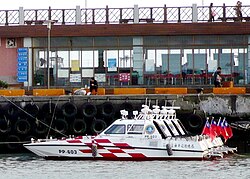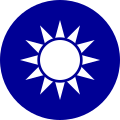| Coast Guard Administration 海洋委員會海巡署 Hǎixún Shǔ (Mandarin) Hái-sûn Sú (Taiwanese Hokkien) Hói-sùn Su (Hakka) | |
|---|---|
 | |
 Flag | |
| Common name | ROC Coast Guard |
| Abbreviation | CGA |
| Agency overview | |
| Formed | February 1, 2000 |
| Employees | 13,061 (2015) [1] |
| Jurisdictional structure | |
| National agency (Operations jurisdiction) | Taiwan |
| Operations jurisdiction | Taiwan |
| Legal jurisdiction | Taiwanese and international waters |
| Constituting instrument |
|
| Specialist jurisdiction |
|
| Operational structure | |
| Headquarters | Wenshan, Taipei |
| Agency executives |
|
| Parent agency | Ocean Affairs Council |
| Website | |
| www | |
The Coast Guard Administration of the Ocean Affairs Council (CGA), also operating as the ROC Coast Guard, is charged with maintaining law and order; protecting the resources of the territorial waters of the Republic of China (Taiwan), which surround Taiwan, Penghu, Kinmen, Matsu Islands, Green Island, Orchid Island, Pratas Island (Tungsha/Dongsha), and Nansha Islands; as well as providing a first line of defense along coastal areas against smugglers and illegal immigrants. The CGA is considered a civilian law enforcement agency under the administration of the Ocean Affairs Council of the Executive Yuan, though during emergencies it may be incorporated as part of the Republic of China Armed Forces. [3]
Contents
- Organization
- Special Task Unit
- Auxiliaries
- Scope
- History
- International cooperation
- Fleet
- Active
- Retired
- Equipment
- Helicopters and drones
- Light weapons
- Heavy weapons
- Ground vehicles
- Coastal surveillance
- Rank insignia
- Leaders
- Ministers (CGA under Executive Yuan)
- Chairpersons (CGA under Ocean Affairs Council)
- See also
- References
- External links











![06.02 Fu Zong Tong Chu Xi [An Ping Ji Xun Fang Jian Di 8Sao CG610Yong Kang Jian Jiao Chuan , Di 9Sao CG611Ming Ming Xia Shui Ji Xin Xing 35Dun Ji Xun Fang Ting Di 31Sao PP-3520Ting Jiao Chuan ] Lian He Dian Li - 53762254857.jpg](http://upload.wikimedia.org/wikipedia/commons/thumb/5/5c/06.02_%E5%89%AF%E7%B8%BD%E7%B5%B1%E5%87%BA%E5%B8%AD%E3%80%8C%E5%AE%89%E5%B9%B3%E7%B4%9A%E5%B7%A1%E9%98%B2%E8%89%A6%E7%AC%AC8%E8%89%98CG610%E6%B0%B8%E5%BA%B7%E8%89%A6%E4%BA%A4%E8%88%B9%E3%80%81%E7%AC%AC9%E8%89%98CG611%E5%91%BD%E5%90%8D%E4%B8%8B%E6%B0%B4%E6%9A%A8%E6%96%B0%E5%9E%8B35%E5%99%B8%E7%B4%9A%E5%B7%A1%E9%98%B2%E8%89%87%E7%AC%AC31%E8%89%98PP-3520%E8%89%87%E4%BA%A4%E8%88%B9%E3%80%8D%E8%81%AF%E5%90%88%E5%85%B8%E7%A6%AE_-_53762254857.jpg/330px-thumbnail.jpg)





![Patrol vessel PP-3581 in 2023 alongside a M109 assault boat 06.10 Zong Tong Shi Dao [Hai An 11Hao Yan Xi ] (52963598571).jpg](http://upload.wikimedia.org/wikipedia/commons/thumb/2/22/06.10_%E7%B8%BD%E7%B5%B1%E8%A6%96%E5%B0%8E%E3%80%8C%E6%B5%B7%E5%AE%8911%E8%99%9F%E6%BC%94%E7%BF%92%E3%80%8D_%2852963598571%29.jpg/250px-06.10_%E7%B8%BD%E7%B5%B1%E8%A6%96%E5%B0%8E%E3%80%8C%E6%B5%B7%E5%AE%8911%E8%99%9F%E6%BC%94%E7%BF%92%E3%80%8D_%2852963598571%29.jpg)


















![12.11 Zong Tong Chu Xi [An Ping Ji Xun Fang Jian Shou Sao An Ping Jian Jiao Chuan Ji Di 2Sao Cheng Gong Jian Ming Ming Xia Shui Ji 35Dun Ji Xun Fang Ting Jiao Chuan Lian He Dian Li ] - 50705063998.jpg](http://upload.wikimedia.org/wikipedia/commons/thumb/2/28/12.11_%E7%B8%BD%E7%B5%B1%E5%87%BA%E5%B8%AD%E3%80%8C%E5%AE%89%E5%B9%B3%E7%B4%9A%E5%B7%A1%E9%98%B2%E8%89%A6%E9%A6%96%E8%89%98%E5%AE%89%E5%B9%B3%E8%89%A6%E4%BA%A4%E8%88%B9%E5%8F%8A%E7%AC%AC2%E8%89%98%E6%88%90%E5%8A%9F%E8%89%A6%E5%91%BD%E5%90%8D%E4%B8%8B%E6%B0%B4%E6%9A%A835%E5%99%B8%E7%B4%9A%E5%B7%A1%E9%98%B2%E8%89%87%E4%BA%A4%E8%88%B9%E8%81%AF%E5%90%88%E5%85%B8%E7%A6%AE%E3%80%8D_-_50705063998.jpg/120px-12.11_%E7%B8%BD%E7%B5%B1%E5%87%BA%E5%B8%AD%E3%80%8C%E5%AE%89%E5%B9%B3%E7%B4%9A%E5%B7%A1%E9%98%B2%E8%89%A6%E9%A6%96%E8%89%98%E5%AE%89%E5%B9%B3%E8%89%A6%E4%BA%A4%E8%88%B9%E5%8F%8A%E7%AC%AC2%E8%89%98%E6%88%90%E5%8A%9F%E8%89%A6%E5%91%BD%E5%90%8D%E4%B8%8B%E6%B0%B4%E6%9A%A835%E5%99%B8%E7%B4%9A%E5%B7%A1%E9%98%B2%E8%89%87%E4%BA%A4%E8%88%B9%E8%81%AF%E5%90%88%E5%85%B8%E7%A6%AE%E3%80%8D_-_50705063998.jpg)
![12.11 Zong Tong Chu Xi [An Ping Ji Xun Fang Jian Shou Sao An Ping Jian Jiao Chuan Ji Di 2Sao Cheng Gong Jian Ming Ming Xia Shui Ji 35Dun Ji Xun Fang Ting Jiao Chuan Lian He Dian Li ] - 50705063996.jpg](http://upload.wikimedia.org/wikipedia/commons/thumb/d/dd/12.11_%E7%B8%BD%E7%B5%B1%E5%87%BA%E5%B8%AD%E3%80%8C%E5%AE%89%E5%B9%B3%E7%B4%9A%E5%B7%A1%E9%98%B2%E8%89%A6%E9%A6%96%E8%89%98%E5%AE%89%E5%B9%B3%E8%89%A6%E4%BA%A4%E8%88%B9%E5%8F%8A%E7%AC%AC2%E8%89%98%E6%88%90%E5%8A%9F%E8%89%A6%E5%91%BD%E5%90%8D%E4%B8%8B%E6%B0%B4%E6%9A%A835%E5%99%B8%E7%B4%9A%E5%B7%A1%E9%98%B2%E8%89%87%E4%BA%A4%E8%88%B9%E8%81%AF%E5%90%88%E5%85%B8%E7%A6%AE%E3%80%8D_-_50705063996.jpg/120px-12.11_%E7%B8%BD%E7%B5%B1%E5%87%BA%E5%B8%AD%E3%80%8C%E5%AE%89%E5%B9%B3%E7%B4%9A%E5%B7%A1%E9%98%B2%E8%89%A6%E9%A6%96%E8%89%98%E5%AE%89%E5%B9%B3%E8%89%A6%E4%BA%A4%E8%88%B9%E5%8F%8A%E7%AC%AC2%E8%89%98%E6%88%90%E5%8A%9F%E8%89%A6%E5%91%BD%E5%90%8D%E4%B8%8B%E6%B0%B4%E6%9A%A835%E5%99%B8%E7%B4%9A%E5%B7%A1%E9%98%B2%E8%89%87%E4%BA%A4%E8%88%B9%E8%81%AF%E5%90%88%E5%85%B8%E7%A6%AE%E3%80%8D_-_50705063996.jpg)
![12.11 Zong Tong Chu Xi [An Ping Ji Xun Fang Jian Shou Sao An Ping Jian Jiao Chuan Ji Di 2Sao Cheng Gong Jian Ming Ming Xia Shui Ji 35Dun Ji Xun Fang Ting Jiao Chuan Lian He Dian Li ] - 50705063997.jpg](http://upload.wikimedia.org/wikipedia/commons/thumb/c/cf/12.11_%E7%B8%BD%E7%B5%B1%E5%87%BA%E5%B8%AD%E3%80%8C%E5%AE%89%E5%B9%B3%E7%B4%9A%E5%B7%A1%E9%98%B2%E8%89%A6%E9%A6%96%E8%89%98%E5%AE%89%E5%B9%B3%E8%89%A6%E4%BA%A4%E8%88%B9%E5%8F%8A%E7%AC%AC2%E8%89%98%E6%88%90%E5%8A%9F%E8%89%A6%E5%91%BD%E5%90%8D%E4%B8%8B%E6%B0%B4%E6%9A%A835%E5%99%B8%E7%B4%9A%E5%B7%A1%E9%98%B2%E8%89%87%E4%BA%A4%E8%88%B9%E8%81%AF%E5%90%88%E5%85%B8%E7%A6%AE%E3%80%8D_-_50705063997.jpg/120px-12.11_%E7%B8%BD%E7%B5%B1%E5%87%BA%E5%B8%AD%E3%80%8C%E5%AE%89%E5%B9%B3%E7%B4%9A%E5%B7%A1%E9%98%B2%E8%89%A6%E9%A6%96%E8%89%98%E5%AE%89%E5%B9%B3%E8%89%A6%E4%BA%A4%E8%88%B9%E5%8F%8A%E7%AC%AC2%E8%89%98%E6%88%90%E5%8A%9F%E8%89%A6%E5%91%BD%E5%90%8D%E4%B8%8B%E6%B0%B4%E6%9A%A835%E5%99%B8%E7%B4%9A%E5%B7%A1%E9%98%B2%E8%89%87%E4%BA%A4%E8%88%B9%E8%81%AF%E5%90%88%E5%85%B8%E7%A6%AE%E3%80%8D_-_50705063997.jpg)
![07.26 Zong Tong Shi Dao [Han Guang 38Hao Yan Xi ] Lian He Jie Ji Zuo Zhan Shi Dan Cao Yan .jpg](http://upload.wikimedia.org/wikipedia/commons/thumb/e/e5/07.26_%E7%B8%BD%E7%B5%B1%E8%A6%96%E5%B0%8E%E3%80%8C%E6%BC%A2%E5%85%8938%E8%99%9F%E6%BC%94%E7%BF%92%E3%80%8D%E8%81%AF%E5%90%88%E6%88%AA%E6%93%8A%E4%BD%9C%E6%88%B0%E5%AF%A6%E5%BD%88%E6%93%8D%E6%BC%94.jpg/120px-07.26_%E7%B8%BD%E7%B5%B1%E8%A6%96%E5%B0%8E%E3%80%8C%E6%BC%A2%E5%85%8938%E8%99%9F%E6%BC%94%E7%BF%92%E3%80%8D%E8%81%AF%E5%90%88%E6%88%AA%E6%93%8A%E4%BD%9C%E6%88%B0%E5%AF%A6%E5%BD%88%E6%93%8D%E6%BC%94.jpg)












